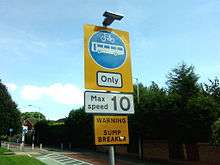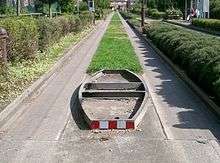Sump buster
A sump buster is a device installed within a bus route to limit that thoroughfare to buses. It discourages traffic from entering a lane by promising to destroy the oil pan of any vehicle with insufficient ground clearance to get over it, making them similar in use (but not design) to rising bollards.[1] A sump buster can also be known as a "sump breaker" or "sump trap".

Function
The sump buster uses a non-mechanical solid mass of concrete (sometimes other aggregates or metal) to demobilise a vehicle when access to a restricted area is attempted. When (for instance) a car attempts to transverse the sump buster, the device will demolish the vehicle's oil pan (literally "busting the sump"). The track (distance between wheels on either side of the vehicle) and ground clearance on permitted vehicles (usually, but not restricted to buses) is such that they may clear the device with ease. In some cases, advisory or mandatory speed limits are given.
Impact on the community
A major purpose of the sump buster is to avoid road systems to be used as rat runs and, to a certain extent, joyriding. For this reason, devices have been vandalised (either through annoyance at their existence or to attempt to gain passage), resulting in accidents (and injuries) to legitimate road users.[2]
In January 2005, Devon County Council dismissed an application by the Stagecoach Group for the installation of a sump buster on Tan Lane (a restricted access road) in Exeter. The Exeter Highways and Traffic Orders Committee stated that "...[using a sump buster] is not an option that the County Council could support [as] it would not differentiate between high clearance vehicles and for example cars and vans that are authorised to use the link under the current Traffic Regulation Order".[3]
Locations of devices


Australasia
Australia
Europe
United Kingdom
Belgium
Sump busters are installed on rural roads in Belgium in order to prevent unwanted traffic by private cars.
Norway
Common in urban areas in south west. Pre-cast concrete blocks, bolted to the ground.
See also
References
- GetReading: "'Panic' behind bugs gate closure"
- "Ten hurt after road hump damaged". BBC. 2005-03-11. Retrieved 2009-10-01.
- "Committee Report". Exeter Highways and Traffic Orders Committee. Devon County Council. 2005-01-27. Retrieved 2009-10-01.
